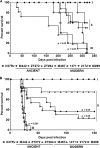Mycobacterium tuberculosis strains of the modern sublineage of the Beijing family are more likely to display increased virulence than strains of the ancient sublineage
- PMID: 24829250
- PMCID: PMC4097719
- DOI: 10.1128/JCM.00498-14
Mycobacterium tuberculosis strains of the modern sublineage of the Beijing family are more likely to display increased virulence than strains of the ancient sublineage
Abstract
Strains of the Beijing genotype family of Mycobacterium tuberculosis are a cause of particular concern because of their increasing dissemination in the world and their association with drug resistance. Phylogenetically, this family includes distinct ancient and modern sublineages. The modern strains, contrary to the ancestral counterparts, demonstrated increasing prevalence in many world regions that suggest an enhanced bacterial pathogenicity. We therefore evaluated virulence of modern versus ancient Beijing strains with similar epidemiological and genotype characteristics. For this, we selected six strains that had very similar 24-locus mycobacterial interspersed repetitive-unit-variable-number tandem-repeat (MIRU-VNTR) typing profiles and belonged to the region of difference 181 (RD181) subgroup but differed using markers (mutT2 and mutT4 genes and NTF locus) that discriminate between modern and ancient Beijing sublineages. The strains were isolated from native patients in Brazil and Mozambique, countries with a low prevalence of Beijing strains. The virulence levels of these strains were determined in models of pulmonary infection in mice and in vitro macrophage infection and compared with that of a strain from Russia, part of the epidemic and hypervirulent Beijing clone B0/W148, and of the laboratory strain H37Rv. The results showed that two of the three modern Beijing strains were highly pathogenic, exhibiting levels of virulence comparable with that of the epidemic Russian strain. In contrast, all isolates of the ancient sublineage displayed intermediate or low virulence. The data obtained demonstrate that the strains of the modern Beijing sublineage are more likely to exhibit highly virulent phenotypes than ancient strains and suggest that genetic alterations characteristic of the modern Beijing sublineage favor selection of highly virulent bacteria.
Copyright © 2014, American Society for Microbiology. All Rights Reserved.
Figures






References
-
- Casali N, Nikolayevskyy V, Balabanova Y, Harris SR, Ignatyeva O, Kontsevaya I, Corander J, Bryant J, Parkhill J, Nejentsev S, Horstmann RD, Brown T, Drobniewski F. 2014. Evolution and transmission of drug-resistant tuberculosis in a Russian population. Nat. Genet. 46:279–286. 10.1038/ng.2878 - DOI - PMC - PubMed
-
- Buu TN, Huyen MMN, Lan NT, Quy HT, Hen NV, Zignol M, Borgdorff MW, Cobelens FG, van Soolingen D. 2009. The Beijing genotype is associated with young age and multidrug-resistant tuberculosis in rural Vietnam. Int. J. Tuberc. Lung Dis. 13:900–906 - PubMed
-
- Hanekom M, van der Spuy GD, Streicher E, Ndabambi SL, McEvoy CR, Kidd M, Beyers N, Victor TC, van Helden PD, Warren RM. 2007. A recently evolved sublineage of the Mycobacterium tuberculosis Beijing strain family is associated with an increased ability to spread and cause disease. J. Clin. Microbiol. 45:1483–1490. 10.1128/JCM.02191-06 - DOI - PMC - PubMed
Publication types
MeSH terms
LinkOut - more resources
Full Text Sources
Other Literature Sources

